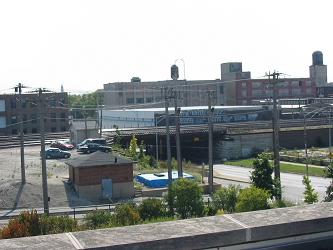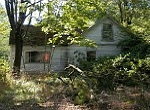Abandoned Factories Present a Challenge for Communities
Last Updated: June 10, 2024
Creative re-use of abandoned factories in your community can mean that an empty industrial building or complex for which there is no real estate market can live again as lofts, artist studios, unusual retail space, or offices for a marketing firm or other creative business.

Listing industrial property for sale doesn't mean that a buyer will appear, especially in areas where an abundant supply means only those spaces with a location advantage have a chance of being purchased.
Pretend that you represent the typical community worried about abandoned factories. You have several, development is stalled in your area anyway, and your once prosperous manufacturing facility rapidly is becoming an eyesore as well as a magnet for unsavory activities. What should you do?
• Contact the owner(s), ask questions, and listen. Try to interest them in working with an aggressive and knowledgeable real estate agent who is tough-minded but hard-working. If you anticipate the owner will need encouragement to find an agent, after perhaps giving up hope, have a list of suggested agents ready.
If you sense that they might be asking too much for the property, have some recent sales data at your fingertips, if indeed there have been any sales of comparable properties in your community. Again, preparation will be useful. Ask enough questions to determine if the building and site probably will be classified as brownfields, if you don't know the exact nature of the manufacturing processes that occurred there over the full life of the factory.
By the way, if you are not familiar with the brownfields issue, be sure to check out our page on that topic using the link above. You really cannot deal with abandoned factories without this understanding. More information on toxic waste also may be helpful in some situations.
Another possibility is that as a community leader or even perhaps as a government official, you are unable to locate the owner, or perhaps you locate the owner but no current employee will connect you with the actual decision maker for the property. In this case, you will need to take your cause to higher and higher levels of responsibility within your local government, enlist the city attorney to assist you, and even ask for help from the state government if all roads seem to lead to a dead end. Someone somewhere probably knows about the property. If no living soul can be located, this might be time for the city or town government to consider condemnation to allow it to take over the property.
• If you represent the municipal government as an elected or appointed official, consider whether the city should buy the abandoned factories to tear them down or re-use them after the lengthy process of environmental review and permitting.
If you are in a true urban environment, you could turn it over to some artists to play with. If you are in a hot housing market, chances are good that you could interest some developers or nonprofit housing developers in producing some new housing after the city has taken care of the environmental hazards. Also you can talk with your economic development staff, boards, and commissions about possible re-use as a business incubator or accelerator if there is a need for more such space, or as a restaurant and entertainment complex.
An interim move might consist of talking with your public library, youth organizations, or science and technology organizations to see if there is an interest in your city's first or next maker space.
I know that municipal budgets are always stretched, but if you're in an environment that might be attractive for other business investment, you can't afford to allow your negatives to scare people away from thinking about the positive.
Hopefully your city has good credit and might be able to secure a loan rather than having to issue revenue bonds. (Bonds aren't a bad choice, but they just are a bit more expensive way to borrow money.)
• Also if you are from the city or one of its boards or commissions, you might suggest casually that the city could consider eminent domain, also known as condemnation, if the abandoned factories or site are not kept in reasonable repair and kept secured, trash-free, pest-free, and graffiti-free. If you are a community group, you simply point out to the owner that you will talk to your city or town government about this possibility.
• The local government should attempt to secure funding for what is called a Phase I environmental assessment if there is any potential for the site to be a brownfield.
Usually if a citizen would use the term abandoned factories, there's some brownfield potential. The Phase I checks into the history of the site and produces some advice on probabilities of brownfield liability.
(Yes, there's a Phase II, and that's a scientific analysis including sampling soil or materials that is required before developing a site found probably to be contaminated or perceived to be contaminated during the Phase I assessment.)
Solutions for Abandoned Factories
First of all, consider that recycling buildings through embracing advanced manufacturing and training your unemployed population at your local community college could be a viable solution.
However, you may find that adequate career training already is available in your community and that market for more manufacturing employment simply doesn't exist. Alternatively, if your workforce is uneducated and doesn't show the potential to complete community college coursework, you may need to consider other land use options as outlined below.
• Aggressively consider how ownership could be transferred to a non-profit organization. Some of them would be resourceful in using it. This is viable only if your potential brownfield situation is favorable of course.
• Study our page on adaptive re-use in general. Some surprisingly interesting housing, for example, has been built within the shell of an old manufacturing facility with great windows, maple floors, interesting machinery or products remaining, and the like. You also may appreciate a story that one of our site visitors submitted about an old industrial site and redevelopment.
• If your city or regional economic development agency can afford it, consider acquiring the property, properly securing and maintaining it while waiting for another manufacturing use. That could be a very long wait indeed, but there is some discussion in the U.S. of the need to bring more manufacturing back within our borders just to prevent supply chain difficulties of the type seen during the coronavirus pandemic. Most of you won't choose that route, but it's worth keeping an eye on national policy if you fail to find a reuse for the factory readily.
• If all else fails, disguise the site. You say, "But it's huge; it's in the middle of town." OK, but can you fence it and have the kids or some artists paint a mural on the fence?
If there's a concrete wall already, paint it, put ceramic tile art on it, or grout broken plates from the neighborhood onto it for your own community form of outsider art. If you can't find viable artists who can work within no budget or a limited budget, maybe you can fasten some large vinyl banners with grommets onto the fence.
If it's impractical to fence, or it would need a fence and you can't afford one, consider landscaping. Are there tall shrubs that grow quickly in your area? Bamboo can grow really fast in even in the Midwest, you know. But of course the bamboo example reminds us to say you need to check out the down side of any plantings you propose. Some types of bamboo spread like wildfire.
If you can't disguise abandoned factories with landscaping or artful fences, distract attention away from the site. Maybe you need to take the drastic measure of creating a dead end street before the road accesses the site.
This doesn't remedy the nuisances that foot traffic can create, and it makes for an even scarier environment for crime and negative activity; however, consider whether this could be suitable for your situation.
Distract with positive new development or public art nearby to encourage foot and car traffic to follow another path.
Finally, our section on beautification and overlapping page on abandoned buildings in general might provide more ideas.
Learn About Related Topics You Should Understand
- Making and Keeping a Good Community >
- Community Challenges, Common Topics & Concepts >
- Redevelopment > Abandoned Factories
Join GOOD COMMUNITY PLUS, which provides you monthly with short features or tips about timely topics for neighborhoods, towns and cities, community organizations, and rural or small town environments. Unsubscribe any time. Give it a try.




